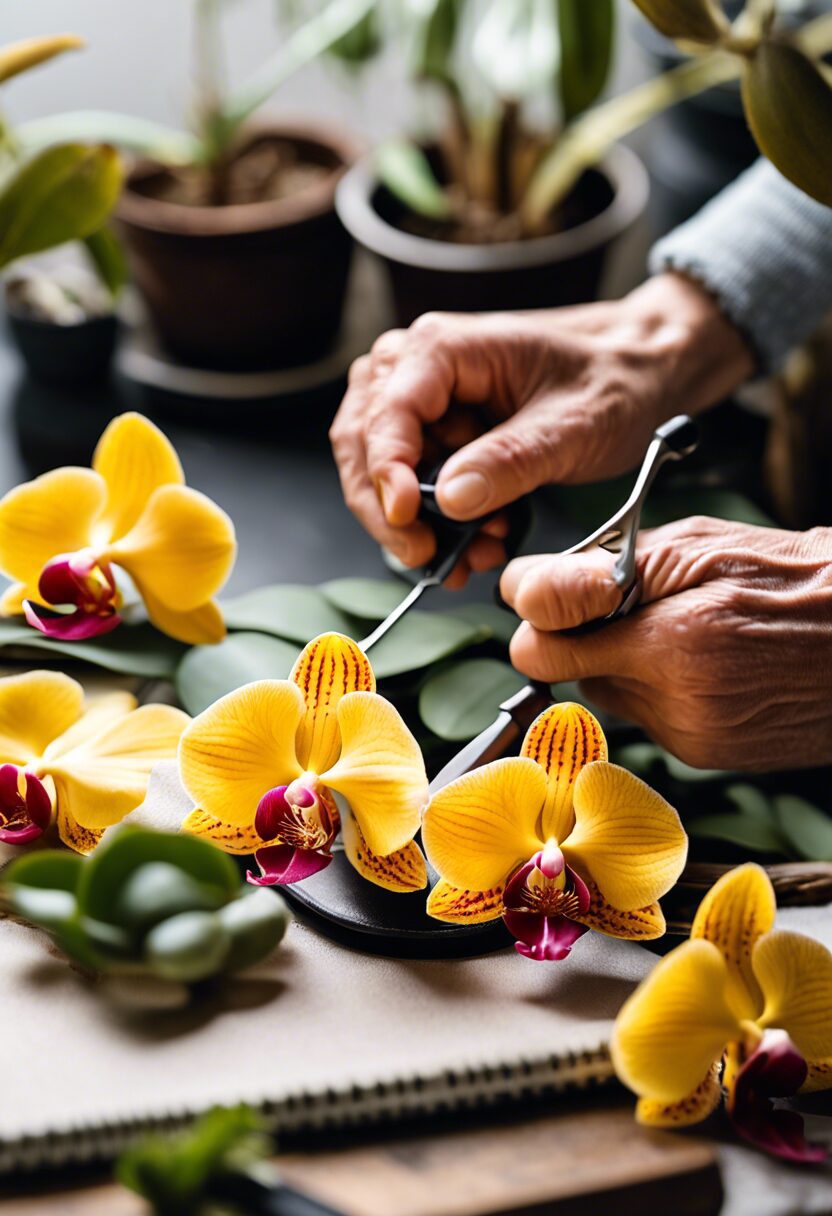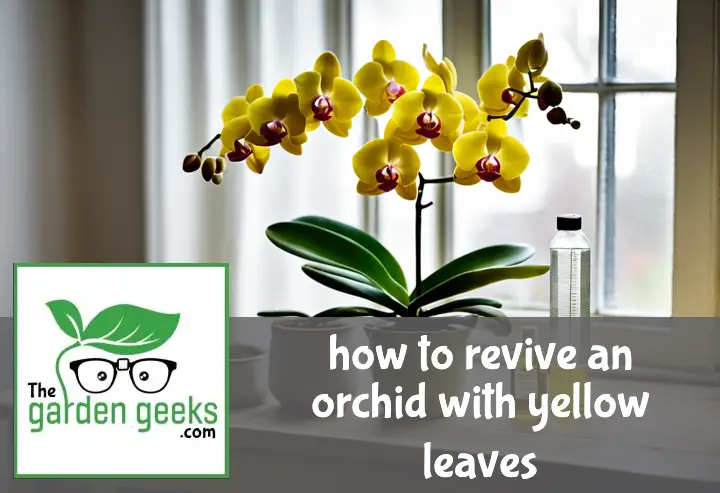Ever gazed at your beloved orchid, only to find its leaves turning a worrisome shade of yellow? Don’t fret, plant parent! I’ve been right there with you, clutching my watering can and wondering what went wrong. But here’s the good news – learning how to revive an orchid with yellow leaves is not as daunting as it sounds.
In fact, it’s quite the opposite. With a bit of patience, some green-thumb-know-how and a dash of love (because who doesn’t talk sweetly to their plants?), your orchid will be back in full bloom before you know it. So roll up those sleeves and let’s dive into this leafy conundrum together, shall we? Keep reading about how to revive an orchid with yellow leaves?
Key Takeaways
- Yellow leaves on an orchid can indicate overwatering, under watering, or a lack of sunlight.
- To revive the orchid, first identify the cause of yellowing. If it’s due to overwatering, reduce the frequency and ensure proper drainage.
- For under watering, gradually increase water amounts.
- If it’s a sunlight issue, move your orchid to a brighter location but avoid direct sunlight.
- Remove severely yellowed leaves with sterilized scissors for the plant’s overall health.

Understanding Yellow Leaves in Orchids
Yellow leaves on your orchid can be a real bummer, right? It’s like the plant equivalent of a bad hair day. But don’t fret! This is a common issue in orchid care and it’s often a sign that your indoor plant buddy needs a bit more TLC.
What Causes Yellow Leaves in Orchids?
So, what turns those green leaves yellow? Well, there are several culprits. Overwatering your orchid is one common cause. Yes, you heard it right! Too much love (and water) can harm your plant.
Another reason could be insufficient light. Just like us, plants need their daily dose of sunshine to stay healthy and vibrant. Nutrient deficiency might also be at play here – imagine trying to function without having breakfast!
And let’s not forget about root rot and temperature stress. Your orchid might be throwing a tantrum because it’s either too cold or too hot, or its roots are drowning.
How to Identify if Your Orchid is Unhealthy?
Now that we know why our orchids might sport yellow leaves, let’s talk about how to tell if they’re feeling under the weather. Apart from the obvious yellow leaves, other signs of an unhealthy orchid include wilting leaves and stunted growth.
If your orchid has drooping flowers or leaf spots, these could also indicate that something’s off. Remember, understanding how to revive an orchid with yellow leaves starts with recognizing these signs early on! So keep an eye out for any changes in your plant buddy’s appearance or behavior.
Diagnosing the Problem
When it comes to figuring out how to revive an orchid with yellow leaves, the first step is always diagnosing the problem. It’s like playing detective, but with plants! The usual suspects are overwatering, light exposure, and nutrient deficiency. So let’s roll up our sleeves and start our orchid yellow leaves diagnosis.
Overwatering and Underwatering: Signs and Symptoms
Overwatering or underwatering your orchid can turn those lovely green leaves yellow. An overwatered orchid often has limp, soggy leaves that might even feel a bit squishy. On the other hand, an underwatered orchid will have wrinkled or shriveled leaves.
It’s all about balance when it comes to watering your orchids. Too much water can drown the roots while too little can leave them parched. So keep an eye out for these signs and adjust your watering routine accordingly.
Light Exposure: Too Much or Too Little?
Just like Goldilocks, orchids need their light just right – not too much, not too little. If your orchid is getting too much light, its leaves may turn a lighter shade of green before eventually turning yellow.
On the flip side, if your plant isn’t getting enough light, its leaves might become dark green and look a bit droopy. Remember, every plant has its own unique light requirements, so make sure you’re giving your orchid what it needs!
Nutrient Deficiency: What Does it Look Like?
Nutrient deficiencies can also cause yellow leaves in orchids. If you notice that only older leaves are turning yellow while new growth remains green, this could be a sign of nitrogen deficiency.
Other common deficiencies include lack of magnesium or iron which can cause leaf tips to turn yellow or brown. So remember folks – feed your plants well! They need a balanced diet just like us.



Reviving Your Orchid


Orchids are like the divas of the plant world – they need a little extra TLC to keep them happy and healthy. But don’t worry, we’re here to help you figure out how to revive an orchid with yellow leaves. It’s all about tweaking your watering habits, adjusting the light conditions, and giving them a nutrient boost.
Adjusting Watering Techniques for Healthier Orchids
When it comes to orchid care tips, watering is key. Overwatering or underwatering can turn those lovely green leaves yellow faster than you can say “oops”. So what’s the secret sauce? Well, it’s all about balance.
Orchids aren’t big fans of soggy feet. Overwatering them can lead to root rot and yep, you guessed it – yellow leaves. On the flip side, underwatering isn’t any better. These divas love their hydration just as much as we do!
The trick is finding that sweet spot in between – not too wet, not too dry. That’s where optimal watering techniques come into play. It’s all about understanding your orchid’s specific water requirements and tailoring your care routine accordingly.
Modifying Light Conditions for Optimal Growth
Next up on our list of orchid revival methods is lighting. Just like Goldilocks, orchids want their light conditions ‘just right’. Too much sunlight can scorch their delicate leaves (hello, yellow!), while too little light can stunt their growth.
But fear not! Modifying these conditions isn’t rocket science. It’s all about observing your plant and making small adjustments as needed.
If your orchid seems to be getting a sunburn (yes, plants get sunburns too), try moving it to a shadier spot or using sheer curtains to filter the light. On the other hand, if your orchid is looking a bit pale and lackluster, it might be craving some more sunshine.
Supplementing Nutrients for Balanced Plant Health
Last but not least, let’s talk nutrients. Just like us humans, orchids need a balanced diet to stay healthy. A nutrient deficiency can lead to all sorts of problems – including those pesky yellow leaves.
But don’t panic! This doesn’t mean you need to start cooking up gourmet meals for your plant (although that would be pretty hilarious). There are plenty of supplements available that can provide your orchid with the essential nutrients it needs.
Remember, reviving an orchid with yellow leaves isn’t about quick fixes – it’s about understanding what your plant needs and adjusting your care routine accordingly. And hey, who knows? With a little patience and TLC, you might just end up with the happiest orchid on the block!
Preventive Measures for Future Care
When it comes to how to revive an orchid with yellow leaves, prevention is better than cure. By focusing on orchid care tips and implementing preventive measures for orchids, you can avoid the yellowing of leaves in the first place. It’s all about maintaining healthy orchids by understanding the key orchid growth factors and planning your future orchid care accordingly.
How to Properly Water Your Orchid?
Watering your orchid correctly is crucial. Overwatering or underwatering can lead to a host of problems, including yellow leaves. So, what are the proper watering techniques for orchids?
Well, it’s not just about pouring water into the pot. You need to consider the hydration needs of an orchid and stick to a consistent watering schedule for orchids. Remember, preventing overwatering in orchids is as important as ensuring they get enough water.
Ideal Light Conditions for Orchids
Next up, let’s talk about light conditions. The optimal light conditions for orchids play a significant role in their health and vitality. Too much sunlight can cause leaf burn in orchids, while too little can stunt their growth.
Understanding the sunlight requirements of an orchid is essential to prevent leaf yellowing and maintain overall plant health. So make sure your green buddy gets just the right amount of rays!
Essential Nutrients for Orchid Growth
Finally, we come down to nutrients – the building blocks of life! Essential nutrients for healthy orchids are like vitamins for us humans; they keep them strong and vibrant.
Nutrient deficiencies in orchids can lead to various issues, including those dreaded yellow leaves. Therefore, fertilizing your orchid properly is vital – think of it as feeding your plant a balanced diet!


To Wrap Up
Just like a sunburned tourist, your orchid’s yellow leaves are crying out for help. But don’t fret! We’ve got the roadmap on how to revive an orchid with yellow leaves.
Remember, it’s all about balance – not too much water nor light, and plenty of love. Now go green-thumb it up and bring that beauty back to life!


